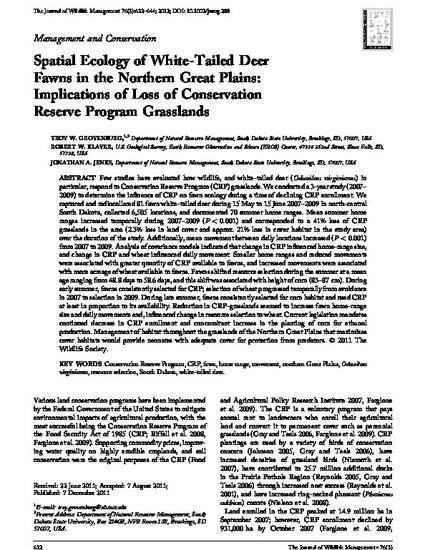
Article
Spatial ecology of white-tailed deer fawns in the northern Great Plains: Implications of loss of conservation reserve program grasslands
The Journal of Wildlife Management
(2012)
Abstract
Few studies have evaluated how wildlife, and white-tailed deer (Odocoileus virginianus) in particular, respond to Conservation Reserve Program (CRP) grasslands. We conducted a 3-year study (2007–2009) to determine the influence of CRP on fawn ecology during a time of declining CRP enrollment. We captured and radiocollared 81 fawn white-tailed deer during 15 May to 15 June 2007–2009 in north-central South Dakota, collected 6,505 locations, and documented 70 summer home ranges. Mean summer home ranges increased temporally during 2007–2009 (P < 0.001) and corresponded to a 41% loss of CRP grasslands in the area (2.3% loss in land cover and approx. 21% loss in cover habitat in the study area) over the duration of the study. Additionally, mean movement between daily locations increased (P < 0.001) from 2007 to 2009. Analysis of covariance models indicated that change in CRP influenced home-range size, and change in CRP and wheat influenced daily movement. Smaller home ranges and reduced movements were associated with greater quantity of CRP available to fawns, and increased movements were associated with more acreage of wheat available to fawns. Fawns shifted resource selection during the summer at a mean age ranging from 48.8 days to 58.6 days, and this shift was associated with height of corn (83–87 cm). During early summer, fawns consistently selected for CRP; selection of wheat progressed temporally from avoidance in 2007 to selection in 2009. During late summer, fawns consistently selected for corn habitat and used CRP at least in proportion to its availability. Reduction in CRP-grasslands seemed to increase fawn home-range size and daily movements and, influenced change in resource selection to wheat. Current legislation mandates continued decrease in CRP enrollment and concomitant increase in the planting of corn for ethanol production. Management of habitat throughout the grasslands of the Northern Great Plains that maximizes cover habitats would provide neonates with adequate cover for protection from predators.
Keywords
- Conservation Reserve Program,
- CRP,
- fawn,
- home range,
- movement,
- northern Great Plains,
- Odocoileus virginianus,
- resource selection,
- South Dakota,
- white-tailed deer
Disciplines
Publication Date
April, 2012
DOI
10.1002/jwmg.288
Publisher Statement
Works produced by employees of the U.S. Government as part of their official duties are not copyrighted within the U.S. The content of this document is not copyrighted.
Citation Information
Troy W. Grovenburg, Robert W. Klaver and Jonathan A. Jenks. "Spatial ecology of white-tailed deer fawns in the northern Great Plains: Implications of loss of conservation reserve program grasslands" The Journal of Wildlife Management Vol. 76 Iss. 3 (2012) p. 632 - 644 Available at: http://works.bepress.com/robert-klaver/35/
